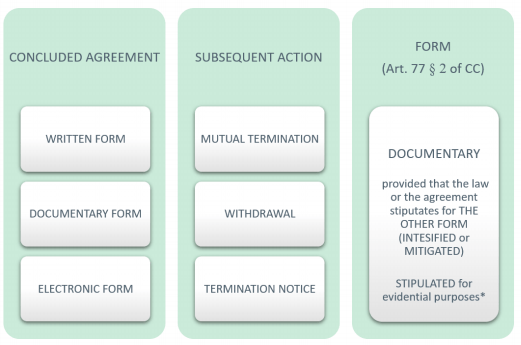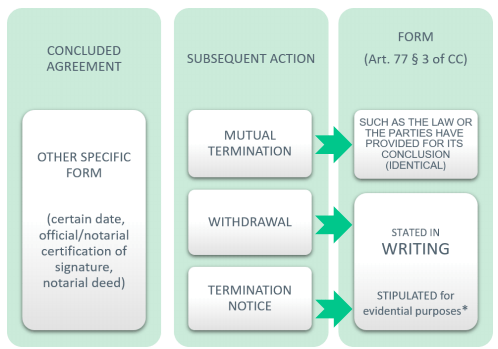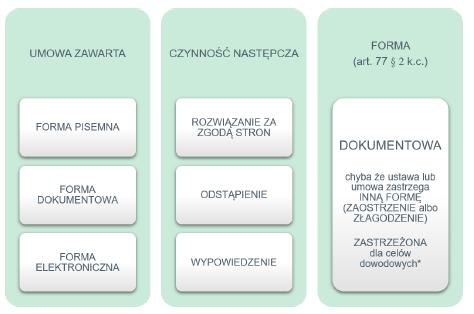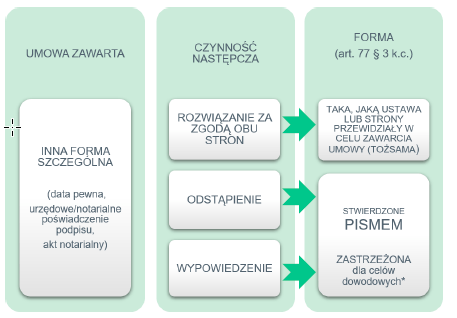- Home
- News & insights
- Insights
- Terminating a contra…
7 April 2020
Terminating a contract – nothing easier?
- QUICK READ
Entrepreneurs are confronted with incredible challenges these days. One of which is taking difficult decisions on terminating a business relationship. In times of the current restrictions and remote communication we advise on how to do this safely and accurately from a legal perspective.
The regulations which govern the so-called subsequent nullifying legal actions i.e. aimed at ending the legal relationship, are as follows:
The current wording of Article 77 § 2 of the Civil Code (“CC”) is the result of an amendment which came into force on 8 September 2016.

Thus, mutual termination, notice of termination or withdrawal from the agreement concluded in writing (Art. 78 of CC), in a documentary form (Art. 772 of CC) or in an electronic form (Art. 781 of CC) shall be made in documentary form, under pain of evidential limitations (ad probationem).
It is irrelevant as to whether the agreement was concluded in writing due to a statutory requirement or a contractual arrangement (pactum de forma) and under what pain the form was reserved.
Therefore, if the agreement does not stipulate any requirements as to the form of the subsequent nullifying legal action (in previous practice the agreements have often regulated the requirement of a form for its change only) and there is no such statutory provision, the agreement can be terminated in the documentary form (e-mail, text message, record, picture, fax), which is less formalised than before the amendment of the Civil Code from 2016 (the written form was foreseen so far).
Moreover, from 8 September 2016, the provision of Article 77 § 2 of CC has an optional nature, thus the parties can decide what form they choose for the subsequent action which nullifies their agreement and it does not have to be a more solemn form (i.e. sharper) than a documentary one. The ,,other form” referred to in this provision may therefore be considered to be any form, even oral.
The statutory rules for terminating an agreement concluded in a qualified specific form, unless otherwise specified, have not changed and are as follows:

Therefore, if the agreement has been concluded in a qualified specific form, withdrawal and termination require the simple written form, under pain of evidential limitations (ad probationem). Such a rule applies regardless as to whether concluding the agreement in one of the qualified special forms was made in accordance with the law or in accordance with the will of the parties.
Attention!
In accordance with Article 74 § 4 of CC, in relationships between entrepreneurs, failure to comply with the requirements of the form, where the pain of nullity has not been stipulated, by the law or the parties (i.e. the form was restricted for evidence purposes only; ad probationem), does not result in evidence sanctions and at the same time does not affect the validity of the performed legal action.
Therefore, the agreement between the entrepreneurs may be withdrawn or terminated in any form, provided that the law or the agreement does not provide for such a declaration to be made in a specific form, otherwise being null and void.
Recommendation
Simple and legally secure solutions work in business. Oral communication, although is in principle allowed, is in line with the rules outlined above, it cannot be trusted. The ,,classic’’ written form is most commonly used, which results from the previous regulations and common practice, especially for the sake of litigation prudence. However, what used to be a rule or commonplace, should now be verified, especially since we can use solutions which are available, cheaper and faster than traditional correspondence.
Therefore, it is worth noting that the Civil Code allows for the use of a documentary form (e-mail, text message, recording, photo, scan, fax) as the form aimed at facilitating the performance of legal actions.
Therefore, if you intend to terminate (or withdraw from) your contract, please follow these criteria:

Wypowiedzenie umowy – nic prostszego?
Przedsiębiorcy stoją obecnie przed ogromnymi wyzwaniami. Jednym z tych wyzwań jest podjęcie trudnych decyzji o zakończeniu współpracy i wypowiedzeniu umów.
Zasady regulujące tzw. następcze czynności prawne niweczące (czyli zmierzające do zakończenia stosunku prawnego) są następujące:
Obecna treść art. 77 § 2 k.c. jest wynikiem nowelizacji Kodeku cywilnego, która weszła w życie 8 września 2016 roku.

Oznacza to, że rozwiązanie, wypowiedzenie albo odstąpienie od umowy zawartej w formie pisemnej zwykłej (art. 78 k.c.), dokumentowej (art. 772 k.c.) lub elektronicznej (art. 781 k.c.) powinno być dokonane w formie dokumentowej, zastrzeżonej pod rygorem ograniczeń dowodowych (ad probationem).
Nie jest istotne, czy umowa została zawarta w formie pisemnej ze względu na wymóg ustawowy, zastrzeżenie umowne (pactum de forma), ani pod jakim rygorem forma ta była zastrzeżona.
Dlatego, jeżeli umowa nie zastrzega żadnych wymagań odnośnie formy czynności następczej niweczącej (a w dotychczasowej praktyce postanowienia umów często regulowały tylko wymóg formy przy jej zmianie) oraz nie ma takiego przepisu ustawy, umowę można rozwiązać lub wypowiedzieć w formie dokumentowej (np.: e-mail, sms, nagranie, zdjęcie, skan, faks), czyli w sposób bardziej odformalizowany niż przed zmianą Kodeksu cywilnego w 2016 roku (dotychczas przewidziana była forma pisemna).
Co więcej, od 8 września 2016 roku przepis art. 77 § 2 k.c. ma charakter dyspozytywny, co oznacza, że strony mogą zdecydować, jaką formę wybierają dla czynności następczej niweczącej ich umowę i wcale nie musi to być forma bardziej solenna (czyli ostrzejsza), niż forma dokumentowa. Za ,,inną formę”, o której mowa w tym przepisie, można uważać zatem "formę dowolną", nawet ustną.
Kodeksowe zasady dotyczące zakończenia umowy zawartej w kwalifikowanej formie szczególnej nie uległy zmianie i jeżeli nie zastrzeżono inaczej, wyglądają następująco:

Zatem, jeżeli umowa została zawarta w kwalifikowanej formie szczególnej, odstąpienie oraz wypowiedzenie wymagają zachowania zwykłej formy pisemnej, zastrzeżonej pod rygorem ograniczeń dowodowych (ad probationem). Rygor taki obowiązuje bez względu na to, czy zawarcie umowy w którejś z kwalifikowanych form szczególnych nastąpiło zgodnie z ustawą lub z wolą stron.
WAŻNE!
Zgodnie z art. 74 § 4 k.c., w stosunkach między przedsiębiorcami uchybienie wymaganiom formy, gdy nie został zastrzeżony rygor nieważności (przez ustawę lub strony), czyli zastrzeżonej tylko dla celów dowodowych (ad probationem), nie skutkuje sankcjami dowodowymi, a jednocześnie pozostaje bez wpływu na ważność dokonanej czynności prawnej.
W związku z powyższym, odstąpienie albo wypowiedzenie umowy między przedsiębiorcami może nastąpić w dowolnej formie, jeżeli ustawa lub umowa nie przewidują dla takiego oświadczenia wymogu zachowania określonej formy pod rygorem nieważności.
REKOMENDACJA
W biznesie sprawdzają się rozwiązania proste oraz bezpieczne prawnie. Komunikacja ustna, mimo że jak wynika z wyżej przedstawionych reguł, jest w zasadzie dozwolona, to jednak nie cieszy się zaufaniem. Najczęściej stosowana jest ,,klasyczna” forma pisemna, co wynika z dotychczasowych przepisów oraz powszechnej praktyki, szczególnie z tzw. ,,ostrożności procesowej’’. Jednakże, to co dotąd było regułą lub przyzwyczajeniem, dziś powinno ulec weryfikacji, tym bardziej że możemy skorzystać z rozwiązań, które są dostępne, tańsze i szybsze niż tradycyjna korespondencja.
Dlatego warto odnotować, że Kodeks cywilny umożliwia stosowanie formy dokumentowej (e-mail, sms, nagranie, zdjęcie, skan, faks), jako formy mającej na celu usprawnienie dokonywania czynności prawnych.
Zatem, jeżeli zamierzasz wypowiedzieć Twoją umowę (albo od niej odstąpić), kieruj się następującymi kryteriami:

